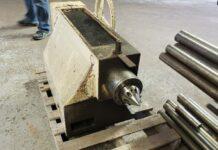Recently, the EPA released the findings for its study on the human health impact of hexavalent chromium. The dangers of this chemical, also known as Cr(VI) and usually produced by an industrial process, are widely known in the workplace and proven to cause many illnesses in humans, including cancer. The EPA will likely use its study, released in October 2022, to eventually set expansive new regulatory standards for the chemical.
Theatergoers might remember that it was this same chemical that provided a key plot point in the Julia Roberts movie “Erin Brockovich.” In the film, the title character fights for citizens of a California town to receive legal monetary damages from a company exposing nearby residents to ailments caused by hexavalent chromium.
The illnesses in “Erin Brockovich” are caused by contaminated groundwater, but humans are often just as vulnerable to Cr(VI) exposure from unsafe conditions in the workplace. Keep reading to learn how industrial robots can help remove human workers from hazardous environments, but first, let’s take a deeper look at Cr(VI).
Hexavalent chromium at work
Human exposure to hexavalent chromium is widespread in various industrial processes, including:
- Electroplating: Cr(VI) is produced during the electroplating process when a current is passed through a solution containing chromium ions. The process produces a hard, durable and corrosion-resistant coating on metal objects.
- Welding and cutting: Cr(VI) is generated during welding and cutting processes involving stainless steel and other alloys containing chromium.
- Painting and coating: Cr(VI) is used in pigments and dyes for paints and coatings. During the painting process, hexavalent chromium can be released into the air as a fine mist.
- Woodworking: Cr(VI) is used as a wood preservative and as a wood stain. During the wood treatment process, hexavalent chromium can be released into the air and water.
- Chemical manufacturing: Cr(VI) is used as a catalyst in various chemical reactions. During these reactions, hexavalent chromium can be released into the air and water.
As documented by the Occupational Safety and Health Administration (OSHA), in all of these industries, vulnerability to respiratory problems caused by inhalation of Cr(VI) is significant, due to potential damage to the lungs and airways. But harmful exposure can also occur due to ingestion or contact with the skin.
The health risks
There have been many studies on the potential health risks associated with working around hexavalent chromium. As previously mentioned, one of the most serious is the potential for respiratory and lung cancer linked to inhalation of the chemical.
But there are also a variety of other serious health effects that have been connected to Cr(VI) exposure:
- Respiratory problems: Inhalation of Cr(VI) can cause irritation of the nose, throat and lungs, leading to respiratory problems such as asthma and bronchitis.
- Skin irritation and dermatitis: Cr(VI) exposure can cause skin irritation, redness and dermatitis.
- Eye irritation: Exposure to Cr(VI) can cause eye irritation, conjunctivitis and damage to the cornea.
- Kidney damage: Long-term exposure to Cr(VI) has been associated with kidney damage and increased risk of kidney cancer.
- Gastrointestinal problems: Ingestion of Cr(VI) can cause gastrointestinal problems such as abdominal pain, vomiting and diarrhea.
- Reproductive problems: Exposure to Cr(VI) can affect fertility and may increase the risk of birth defects in children.
The severity of these health effects can vary depending on the duration and intensity of the exposure, as well as other individual factors such as age, health status and genetic susceptibility.
The EPA’s study
Among the findings of the EPA’s study are that humans risk exposure to hexavalent chromium in many different industries and in several different ways. The study states that:
Occupational exposures to Cr(VI) occur primarily via inhalation or dermal contact and typically exceed those of non-occupational exposures. Workers can potentially inhale Cr(VI) during its processing or manufacture and when working with mixtures containing the chemical or chemical precursors. Dermal exposures may potentially result from the splashing or spilling of chromium-containing materials that contact the skin or from contact with construction materials containing Portland cement (due to a Cr(VI) impurity). Portal-of-entry sites may be exposed via hand-to-mouth contact and hand-to-nose contact and the extent of these transfers depends on the industry, exposure matrix, and workplace hygiene practices. Industries that may have workers who are in contact with Cr(VI)-containing materials include stainless-steel welding, painting, electroplating, steel mill, iron and steel foundries, wood preserving, and occupations that produce paints, coatings, inks, plastic colorants, chromium catalyst, and other chemicals (such as chromium dioxide and chromium sulfate) Other industries with limited potential exposures to Cr(VI) compounds include textile dyeing, glass production, printing, leather tanning, brick production, woodworking, solid waste incineration, oil and gas well drilling, construction and Portland cement production.
A further finding of the study relates to the EPA’s concern about community exposure to Cr(VI) in even trace amounts, including in municipal water supplies. This underscores the importance of minimizing or eliminating human exposure to larger amounts of the chemical in industrial workplaces.
How robots can help
As described above, humans face significant health risks from working with hexavalent chromium. But robots do not, and automated solutions can keep humans from needing to work directly with Cr(VI) and other hazardous chemicals. Certainly, one of the strongest arguments for robots is their ability to protect humans by safeguarding them from working in the types of dangerous occupations that often threaten worker safety.
For example, in the aerospace industry, recoating the inlets of F-22 fighter jets was once a manual process that required extensive manual labor and significant human exposure to the coating material. But now, the installation of turnkey robots can eliminate the need for humans to work in the confined spaces of aircraft inlets.
A 2022 study by the National Library of Medicine found that the use of robots for repetitive site work can reduce unsafe, monotonous tasks by 25-90%, lowering human exposure to hazardous situations by an average of 72%.
But it’s important to work with a robotic integrator affiliated with the Robotic Industry Association (RIA). To minimize human exposure to danger while also gaining the benefit of robotic solutions’ potential cost-savings, it’s critical to install the right robot and with the correct implementation. Moreover, any robotic set-up should have a risk assessment performed to ensure that RIA standards are met.
Measures that a compliant robotic integrator might recommend meeting those standards include:
- Extra sensors
- Emergency stop buttons
- Scanners that detect human presence in unsafe areas
- Fencing off robot work areas
- A safer workplace
Creating a safe workplace in manufacturing industries that protects humans from the effects of hexavalent chromium, and other occupational dangers, is easier to implement with the right safety solutions in place. These include robot workers, which can never get cancer, respiratory ailments, injuries or skin irritation from contact with chemicals.
The dangers for humans from working with and around Cr(VI) are apparent, obvious and proven. Robots are among the best solutions for keeping humans who work in manufacturing industries safer and healthier.
Chris Kolb is vice president of sales at Aerobotix, an innovative leader in robotic solutions for the aerospace and defense industries. Headquartered in Huntsville, Alabama, the company specializes in the creation of cutting-edge automated robotic solutions for high-value, high-precision components, aircraft and vehicles.





















